| Having trouble viewing this email? View it in your browser | | | |  | Preserving and Promoting Community Trails
in Western Pennsylvania | |
| | |
| | |    |   April storm damage 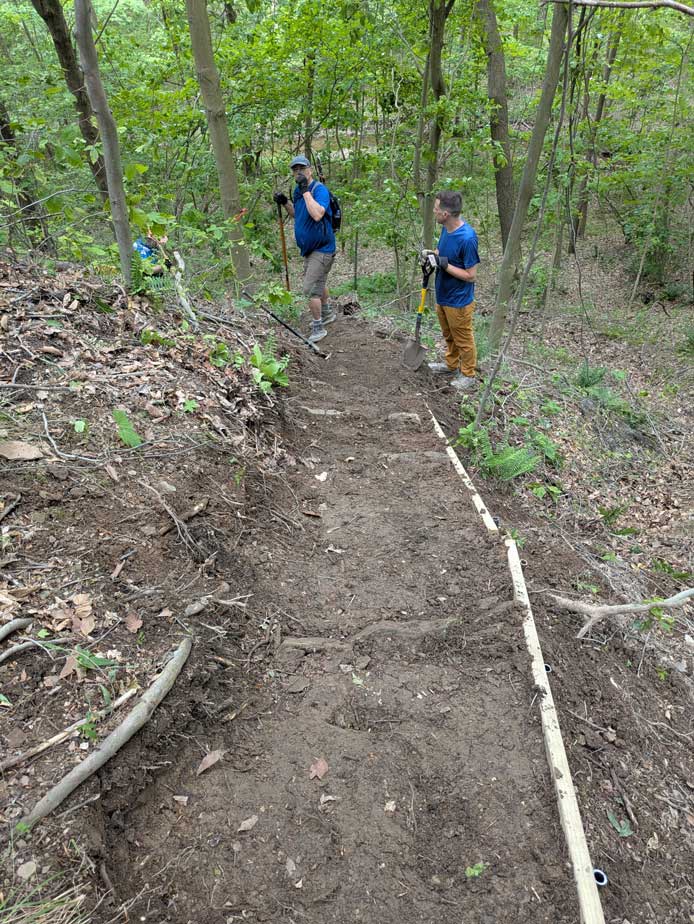 Working on the Rich Hill reroute |  | Rachel Carson Trail Continues to Evolve By Mark Eyerman We achieved a lot with the Rachel Carson Trail over the past year and more is in the works. Here's an update on what's happening. Approximately one mile of the trail has been permanently protected by the purchase of the Miller properties by the Pa Game Commission. This was accomplished through a partnership with the Allegheny Land Trust to preserve over 290 acres of open space. The Game Commission has opened the property as Game Lands #203. Additionally, Indiana Township has purchased almost 60 acres adjacent to Emmerling Park permanently protecting an additional quarter mile of the trail. Through our ongoing efforts and with the help of partner organizations we are securing the future of the RCT. The trail has been rerouted on the Henry property near Rich Hill, moving off of the open pipeline corridor and into the adjacent woods. The hill climb is as high as it's always been, but it's much more pleasant now. Thanks to Elizabeth and Jim Henry for their cooperation with the project and for their ongoing support. A severe storm on April 29 did by far the most damage to the trail in memory. We had to clear approximately 200 downed trees to get the trail back open. Thanks to our Trail Stewards and Trail Crew under the leadership of sawyers Ben Brucker and Tim Deily we were able to clear the trail and get it fully reopened within a month. All while completing the Rich Hill reroute as mentioned above and another smaller reroute. A job well done folks. Efforts continue to construct a spur trail from the RCT along Tawney Run to Rachel Carson Park along the river in Cheswick. As work continues on the redevelopment of the power plant property in Springdale we are advocating for the inclusion of this spur trail into the plans. State Representative Mandy Steele has been a strong supporter of our efforts. We are working with East Deer Township to replace the footbridge behind Par Mar (formerly Sheetz) in Tarentum. East Deer will perform the work and RCTC will pay for the project. We are seeking funding. Expect work to begin in the spring to replace the bridge formerly used by school children at what is now the Magnolia Room with a new one for the community. Thanks to Board of Commisioners President Tony Taliani and property owner Sue Zaleski for helping us make this project a reality. Lloyd Clarke is leading an effort to tame Burtner Hill and make it more hiker friendly. We said goodbye to an iconic Trail Steward this year as Tom Armstrong passed away. Along with his brother John, Tom cared for the 'Mount DiCio' section of the trail for many years. While the loss is deep, we have many fond memories to remember Tom. While we've accomplished a lot and the trail is in the 'best shape ever', there's a lot more we hope to accomplish. Our core volunteers are aging and we're looking for fresh blood to invigorate the team. Please consider joining our team, as much or as little as you are able will help make the trail even better. Contact us at info@rachelcarsontrails.org. |
  Trail Magic Flows Both Ways By Dewaine Beard On the Rachel Carson Trail, brutally steep hills earn a name. I remember the first time I found myself at the bottom of Rich Hill, just north of Emmerling Park. My heart sank to the bottom of my muddy shoes at the idea of climbing, almost hand over hand, up the deeply eroded crevasse and out of sight beyond the first false summit under the hot June sun. Elizabeth and Jim Henry call Rich Hill their home. Elizabeth’s grandfather bought the property in the 1930s and she remembers going down the hill to find wildflowers in the spring as a little girl. Her grandmother would warn her to, “zig zag on your way back up. It’s too steep!” When Elizabeth grew up and moved to the Denver, Colorado area, her love of the outdoors continued. Living there she saw the community enthusiasm for the annual Bolder Boulder, a 10K event for runners, walkers, and wheelchair racers – the 2nd largest such event in the US. People would bring out cotton candy, orange slices, bananas, and cheer the participants on. Elizabeth and Jim moved back to Pennsylvania and began to build their home on the property in 2015. Leaving the construction site with Jim one rainy, miserable day she recalls hearing voices from the other side of the woods. When they made their way to the gas pipeline they found a string of muddy 2015 Challenge participants. They told Elizabeth and Jim about the annual event and that year’s Harrison Hills Park destination. Despite being filthy dirty, Elizabeth was impressed by their enthusiasm for “this challenge thing”. The next summer, inspired by the Bolder Boulder experience, the Henrys wanted to show support for the RCTC hikers that managed to get to the top of Rich Hill. Since there wasn’t any electricity on the pipeline, they set up a cooler with ice pops, and a welcome bit of trail magic tradition was born. Stories of the treat at the top of the hill were retold by hikers and the idea caught on. This past year, all over the challenge course, people set up unofficial aid stations. The magic has spread. In this story, the magic has worked both ways. In 2025, to combat the erosion on Rich Hill and improve the hiking experience, volunteers from the conservancy moved the trail into the woods and added “zig zags”. This significant change happened to coincide with a couple of serious surgeries for Jim Henry. The newly renovated trail and the Henry’s new puppy Nico have become a key part of Jim’s return to health. Now Jim and Nico can walk down to the stream and back regularly and rest on the new bench halfway up. Jim’s stamina is returning and Nico is delighted to stare at the deer and search for chipmunks along the way. |  | 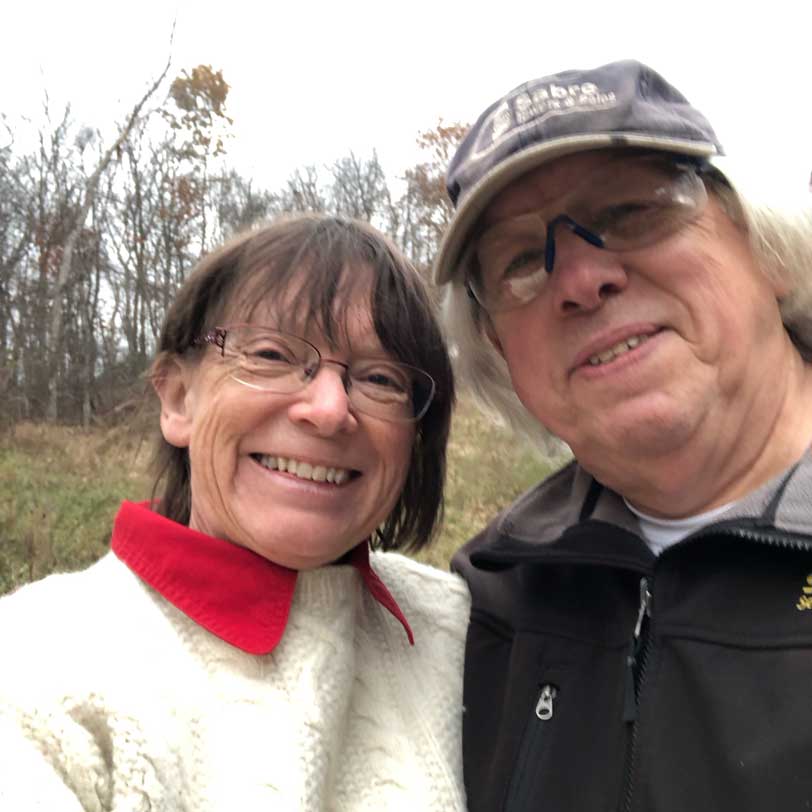 Elizabeth & Jim Henry |
  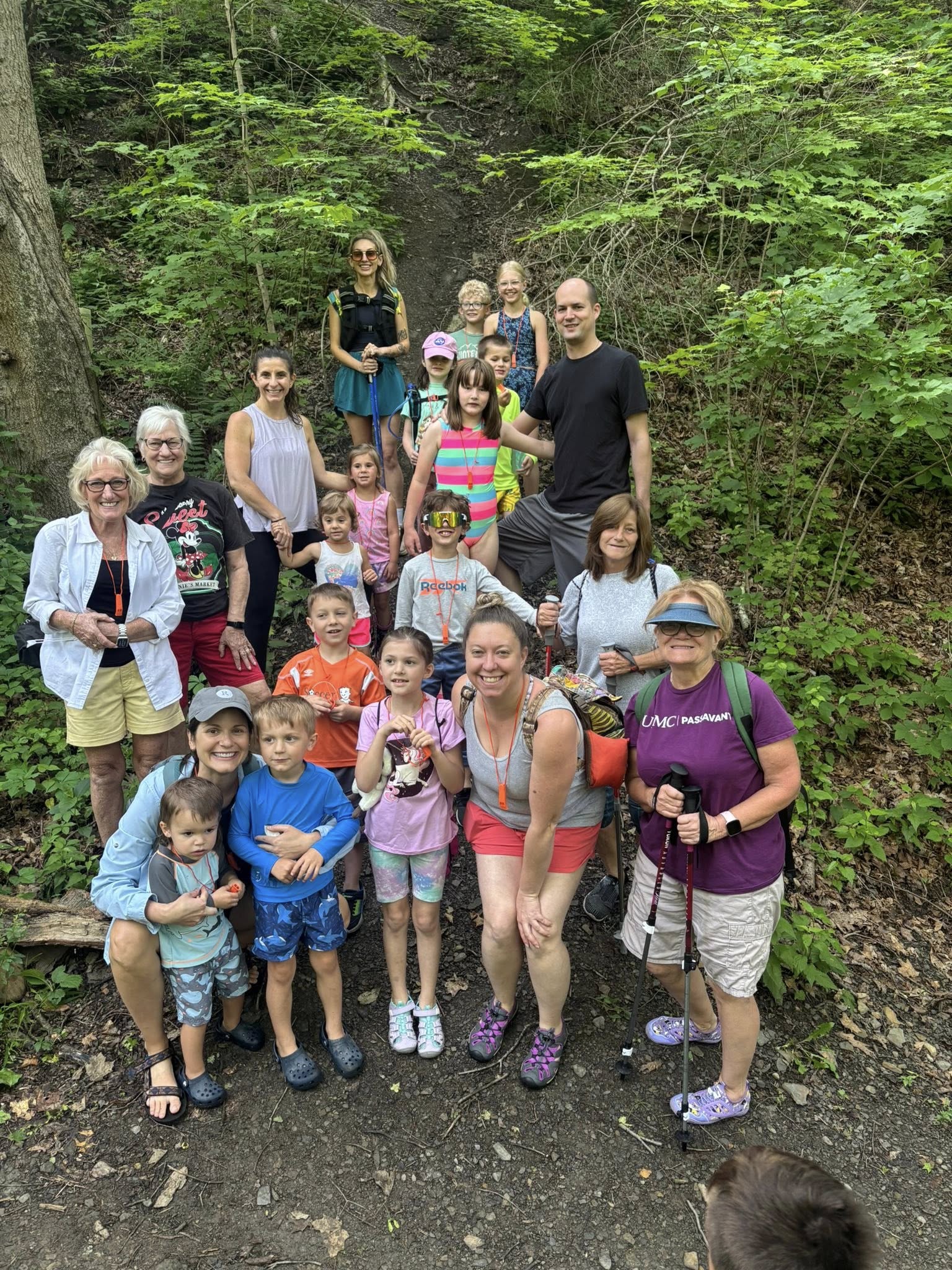 Grandma & River hike group  Exploring the creek |  | Wholesome Adventures for Kids By Kathleen Ganster There is nothing more joyful that watching children playing outside in nature, splashing in creeks, and skipping rocks or exploring trails and looking for creepy crawly things. But numerous studies show that children spend less time in nature now than any previous generation. And that lack of exposure and play outdoors can come at a cost: time and play in nature can assist cognitive development including creativity and focus and of course, the benefits physically are numerous. Like their adult counterparts, time in nature can help reduce children’s stress and anxiety. Taking children on hikes in beautiful Western PA along the Rachel Carson Trail is an easy way to provide opportunities for exploring and playing in nature. In summer 2024, the RCTC launched the “Grandma & River” hikes that I lead, accompanied by my then 3 ½ year old grandson, River. We hosted a series of hikes along Crouse Run, the Harmony Trail and Emmerling Park. This past summer, River (now 4 ½) once again offered the hikes adding a fourth in Hampton Community Park (unfortunately, that one was rained out). The hikes were simple, slow-paced walks from one to two miles long that allowed the shortest of legs to keep up and explore. We were able to take advantage of nearby creeks for water play with each hike and the children really took advantage of those opportunities! Participants were much muddier and wetter after our hikes. “Flynn asked if he could get his shoes wet. As a Mimi I said why not, we're on an adventure!” Linda Marty said who attended with her grandson. According to Victoria Schuster, her daughters. Sloane, 4, and Maxine, 3, also took advantage of the creek. “We really enjoyed our Grandma & River hike because we saw a new trail that offered kid friendly access into nature. My girls loved splashing in the creek to spy for salamanders. Mark (Eyerman) even pointed out a water snake to them. The trail is also convenient to access and navigate - close parking, and kid friendly terrain,” she said. Children were also provided a small snack and a hiking-related “prize” – a compass, hiking whistle, small flashlight with instructions on how to use and why these tools are important for hikers. JoAnn Davis also attended with her grandchildren, “Starting with getting a safety whistle, Kathleen made our adventure filled with discovery and fun! We ended with muddy shoes and talks of the frog and creatures we found. It was a great hike to share with grandkids!” Stay tuned for more Grandma & River hikes! |
  Share Your Ideas for the Woodlands of the Riddle Run Valley By John Stephen The Agan Park Joint Recreation Board and the Rachel Carson Trails Conservancy are inviting the public to help shape the future of one of the region's most unique natural landscapes: the woodlands of Riddle Run Valley. The two organizations have launched a Conservation and Recreation Plan to guide investment, conservation, and recreation programming for the Valley—a remarkable greenspace that stretches from the stream valley floor up to the ridge line overlooking the Allegheny River and New Kensington. The Plan will serve as an implementable vision for protecting natural resources while expanding opportunities for outdoor recreation, community gathering, and environmental education. The planning process officially kicked off with a public meeting in late October. The open-house style meeting featured maps and poster boards that reflected the consultant’s presentation of the project's goals and early findings from the inventory of the Valley’s assets. Residents, hikers and woodlands users are encouraged to complete this online survey to share their interests and vision for the future. By combining conservation with recreation, the Conservation and Recreation Plan aims to ensure these woodlands remain a vibrant, accessible, and beloved greenspace for decades to come. Another public meeting will be scheduled for the spring with more definitive project concepts and implementation plans. The final Conservation and Recreation Plan will serve as a guiding blueprint for the next generation of trail and community leaders, helping shape everything from woodland protection and green space stewardship to trail development, park improvements, and new recreation programs. |  | 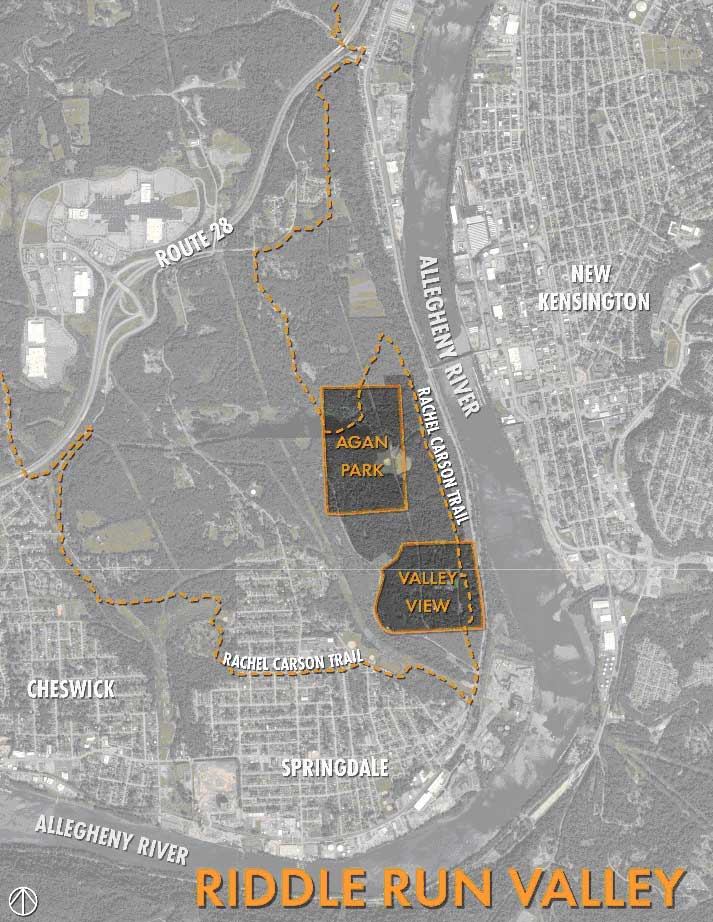 Map of Riddle Run valley |
   Forest Bathing session  Crouse Run Forest Bathing group |  | Forest Bathing: Soap for the Soul By Kathleen Ganster The words "Forest Bathing" may conjure up some interesting thoughts when you hear them for the first time. After all, Forest Bathing is relatively new to the United States. But Forest Bathing is a well-known Japanese Practice of Shinrin-Yoku – Forest Bathing in English – according to Dr. Doug Jones, a Forest Therapy Guide. "Forest Bathing is a leisurely, sensory-based walk in the woods, where we concentrate on the sights, sounds, smells, touches, and tastes of nature. This is neither a naturalist exploration nor a fitness trek; instead, this walk is about absorbing the health benefits of spending relaxed time in nature. It’s also about repairing and nurturing our relationships with nature, ourselves, and others," Jones said in an introduction to the walks. This past summer, the Rachel Carson Trails Conservancy offered two sold-out Forest Bathing walks along beautiful Crouse Run and Pine Creek. Dr. Jones, who is an experienced guide, trained and certified by the Association of Nature and Forest Therapy Guides and Programs (ANFT), led both sessions. Before launching his Forest Therapy practice, Dr. Jones worked as an independent psychologist in Sewickley, Pennsylvania, and at Sewickley Academy for over 30 years. When Dr. Jones retired, he decided to guide walks to remain in service to others and nature. He said that the experiences during a Forest Therapy walk allow participants to reconnect and embody their sense of being at home in nature and with themselves and others." The ANFT motto is ‘The forest is the therapist; the guide opens the doors’." Dr. Jones said. Dan Maltese, one of the participants, said, "The name alone - forest bathing - initially piqued my curiosity and I am so glad that I took part in the walk. In today’s day and age, it seems like all of the news is bad. For me, the body craves quiet time in the woods," he said. "Forest Bathing was a good reminder to take the time, focus on the good, and learn to block out the background noise. I found the walk to be a great reminder that we all know what we should do, we just need to take the time to actually do it," Dan continued. He also found the area of the walk fascinating. "At 61, I realize that I am never too old to learn new things," he said, "Learning about the rich history of Crouse Run was more than enough for me to call the trip a success. I had no idea about the trolley and the lodge but especially the influence that the valley had on a young Rachel Carson. Learning about the ‘cold valley’ and the unique habitats and rich biodiversity found there was also very interesting." The Forest Bathing walks also involved sharing experiences for those who wished to share. "It was especially interesting to listen to what other people got out of the different stops along the way. We were all in the same place, looking at pretty much all of the same things, yet everyone took something slightly different away with them," Dan said. Dr. Jones has guided over 100 walks in Pittsburgh and Northwestern Michigan including offering walks in Crouse Run and Emmerling Park. "I love guiding forest bathing on the Rachel because within moments from any trailhead we’ve left the urban landscape behind, and are immersed in Western PA’s natural sensory diversity of rocks, hills, runs, meadows, unique mix of plants, and exuberant animal life," he said. Dr. Jones continued, "Slowing down on a trail that most often is used for cross country treks, guides you toward finding yourself as a part of these wilds, no longer merely a visitor or passing through. Forest Bathing opens you to a deeper level of experiential appreciation of the trail for which you were already grateful." The RCTC plans to offer more Forest Bathing walks in the future. If you are interested in being notified about them, please email kganster@verizon.net. For more information about Dr. Jones and his Forest Bathing offerings, visit www.forestbathingfinder.com. To learn more about Forest Bathing visit www.anft.earth. |
  Why Is There a Bridge in the Parking Lot? By Bob Mulshine If you drive by the Harmony Trail parking lot on Route 910 you will probably notice a fully formed metal bridge sitting where cars would park. Accompanying it is a medium sized crane. It has been there for weeks and will potentially remain until spring. It is a stark reminder of how difficult it is to extend hiking corridors across major roads in our crowded county. Pine Township has made a significant commitment to accommodating non-motor vehicle traffic by engineering a safe crossing of Route 910 which has grown to be very busy. Their plan is to use the bridge to bring trail users across Wexford Run west (toward Route 79) along Route 910 to a spot across from the new Brennan Road. A set of blinking yellow lights and a crosswalk will allow people to safely cross to the other side of Route 910. Pine has installed sidewalks down to the old Brennan Road section where a path put in by the Wexford Station Development affords trail users a crushed gravel surface up to just before Bradford Woods. |  | 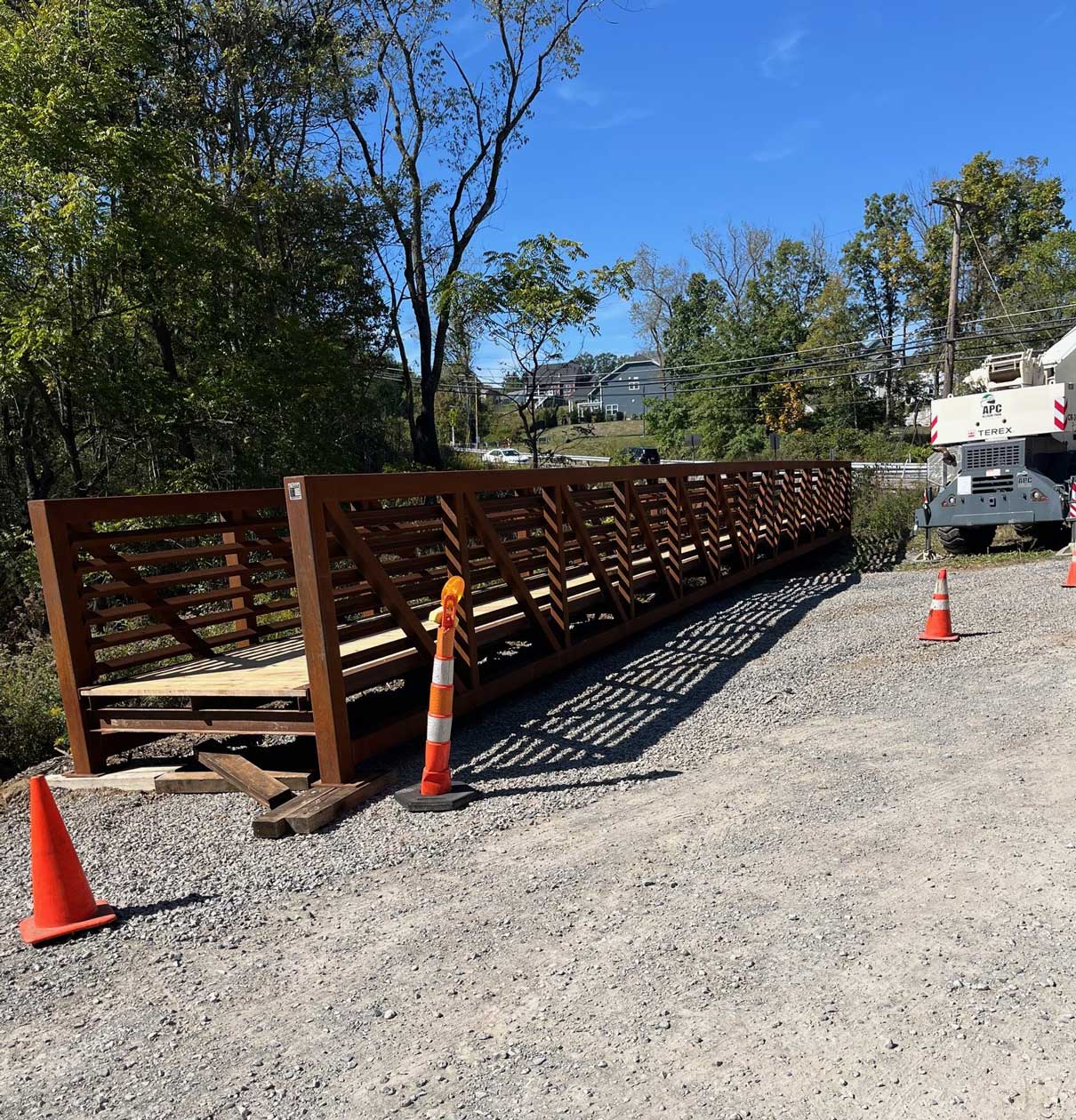 Wexford Run bridge awaiting installation |
  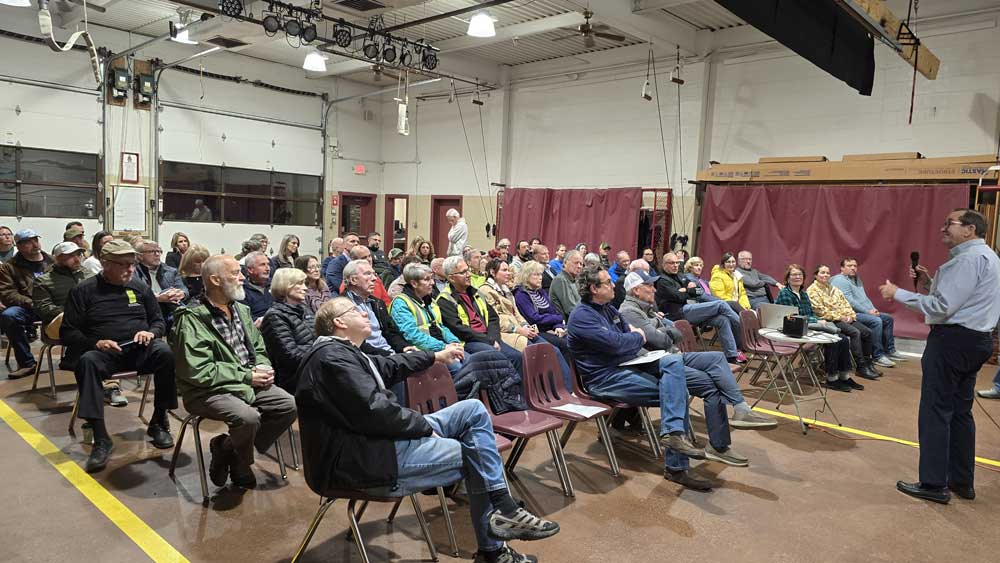 Bob Mulshine speaks to Bradford Woods residents |  | Bradford Woods Discusses Walking Routes By John Stephen The Bradford Woods Conservancy and the Borough of Bradford Woods recently co-hosted a meeting with the Rachel Carson Trails Conservancy to explore opportunities for new community trail connections along the former Harmony Short Line corridor. John Stephen and Bob Mulshine outlined the ongoing work of the Harmony Trail Committee and described the potential for extending the existing Harmony Trail into a broader network of local walking routes. Jack Casey shared updates on related trail efforts in McCandless, and Bill Campbell provided news on progress in Marshall Township. One topic that has been generating particular interest among all local residents is the pedestrian bridge currently staged at the Harmony Trail trailhead on Route 910. This bridge will span Wexford Run parallel to the Route 910 bridge and link to a new walkway leading up to the Brennan Road intersection. Once installed, the bridge and the safer road crossing will provide access to trails within the Wexford Station development and create a continuous route for the Harmony Trail Greenway as it continues north towards Bradford Woods. The November 19 meeting offered residents a preview of future opportunities for walking connections to Bradford Woods Elementary, Marshall Middle School, Shenot Farm, Station 5 Coffee, and nearby neighborhoods—strengthening both mobility and community cohesion. For more information about the Harmony Trail Committee or progress on the Harmony Greenway, contact John Stephen at 412-606-7149 or john.stephen@rachelcarsontrails.org. |
  How I Got Involved By Devin Misour My journey with the Rachel Carson Trails Conservancy nominally began in the spring of 2008. Fresh off my first half-marathon finish, a friend told me that the Rachel Carson Trail Challenge would be a good next step, and that my training for a road half marathon would serve me well as sufficient preparation to take on the then-34-mile Challenge. (Note: that suggestion was incorrect.) Fast forward a couple months, to June 21, 2008. I had maintained my “fitness” with some additional running, a bit of hiking, and a couple laps up a steep hill in my neighborhood for good measure (and to break in my brand-new trail shoes). I felt ready and was eager for the predawn start at Harrison Hills Park, confident that the hike would be challenging but manageable. In retrospect, I now realize that the start that morning, along with the first 30 or so miles that day, were just a prelude to a journey that continues to this day. My real journey with the Challenge, the Trail itself and the Conservancy more broadly began in earnest on a fallen log in a clearing along Crouse Run. That’s where I first cried uncle and laid down, broken, with all but one other companion having dropped out. And that’s where I started saying things that I thought people only said in movies, in places far more extreme than a valley behind what is now a pizza parlor. Things like “just tell them where you left me…” and “I’m just going to lay here a bit longer…” and other—less appropriate—observations about the event. The next few hours as I dragged myself to the finish were…difficult. And the next few days did not see much improvement. But once the fatigue and nausea subsided, lessons became clear. Lessons about the humility that is required to endure a long day on your feet, the food and water required to fuel such days, and the training—the significant training—that is required to prepare your body and mind for the Challenge. For several years after my first Challenge, I continued to be drawn to the event and the suffering it brought with it. I experimented with different distances, trained harder, and even ran the Trail here and there. During those years, my relationship with the Rachel Carson Trail was mostly a solitary pursuit—competing with myself and trying to better my own results. Then, having tried most of the options available (both directions, whole and half Challenges alike), I felt drawn to something else—not just the Challenge, but the Rachel Carson Trail itself. A trail that seemed to be hidden in plain sight. I became fascinated with how it exists in places where many people go about their daily lives—yet they know nothing about what those yellow rectangles mean. I was inspired by the regular folks who show up—year after year—to spend one of the longest days of the year making and handing out peanut butter and jelly sandwiches to sweaty, exhausted strangers. Or the people who spend the other three seasons cutting trees and building steps in the middle of the woods, sometimes miles from any road. To put it bluntly, I began to love the trail and the people who loved it back—because I was one of them. And that love is what drew me to serve. To join the volunteers, managers, and the board members who make this whole thing work and who keep the culture of this trail alive. As so many journeys do, my own journey with the Rachel Carson Trail eventually led me back to that clearing this past summer as a Board member on a forest bathing hike (which I strongly encourage people to try). We were instructed to pick a spot to reflect and pay attention. I chose a spot staring straight at my log, which, believe it or not, is still there. Of course, it is a bit more decomposed than it was that summer afternoon in 2008 (I know the feeling). But like that log, I’m still around. Although my role has changed, I’m still hiking, still trying to spend as much time as possible in these beautiful Western Pennsylvania hills, and—perhaps most important—I’m still trying to learn lessons from the land and this Trail we all love so much. |  | 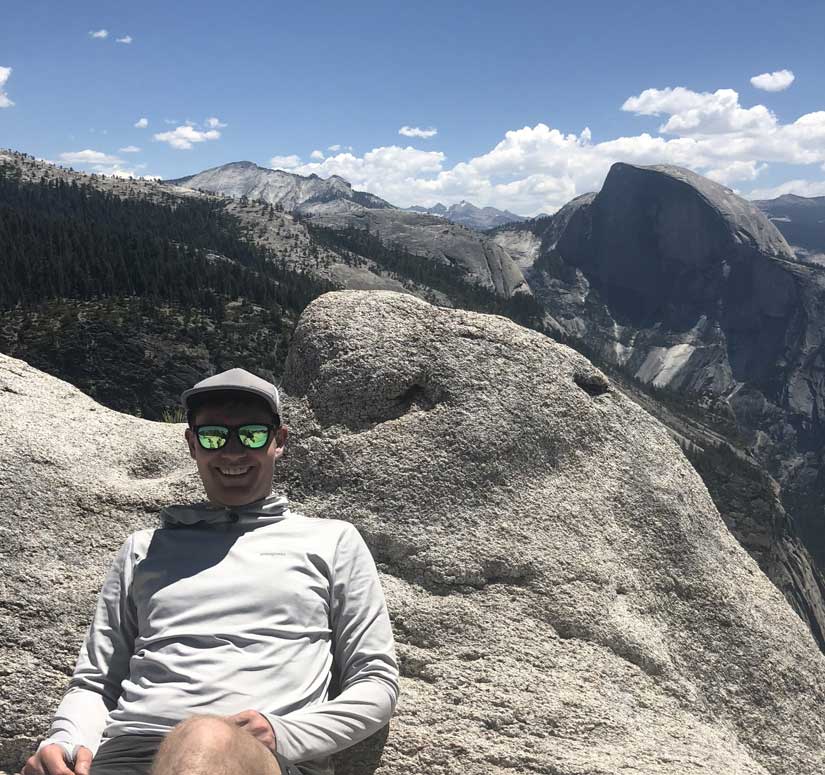 Yosemite in view of Half Dome 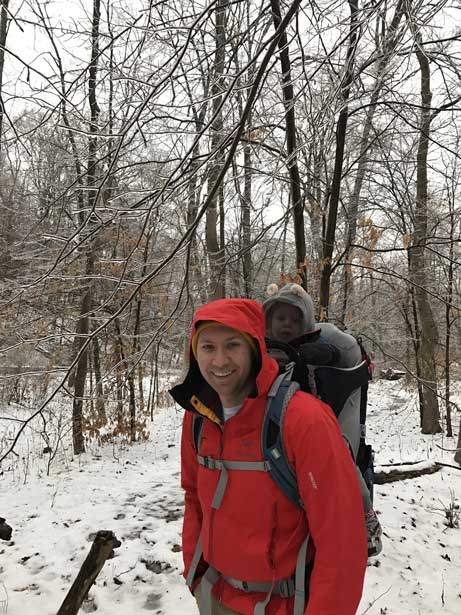 Hemlock Hollow, Fox Chapel |
  | |
 | | |
| |
|